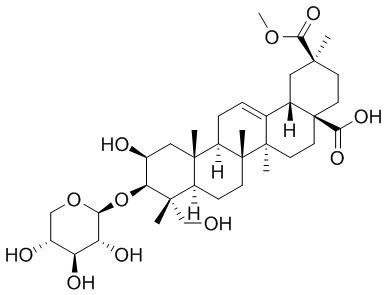Esculentoside B
Phytolaccoside B(Esculentoside B) is an antifungal monodesmoside triterpenoid glycoside, it has potent inhibitory activity against agrobacterial plant transformation.
Inquire / Order:
manager@chemfaces.com
Technical Inquiries:
service@chemfaces.com
Tel:
+86-27-84237783
Fax:
+86-27-84254680
Address:
1 Building, No. 83, CheCheng Rd., Wuhan Economic and Technological Development Zone, Wuhan, Hubei 430056, PRC
Providing storage is as stated on the product vial and the vial is kept tightly sealed, the product can be stored for up to
24 months(2-8C).
Wherever possible, you should prepare and use solutions on the same day. However, if you need to make up stock solutions in advance, we recommend that you store the solution as aliquots in tightly sealed vials at -20C. Generally, these will be useable for up to two weeks. Before use, and prior to opening the vial we recommend that you allow your product to equilibrate to room temperature for at least 1 hour.
Need more advice on solubility, usage and handling? Please email to: service@chemfaces.com
The packaging of the product may have turned upside down during transportation, resulting in the natural compounds adhering to the neck or cap of the vial. take the vial out of its packaging and gently shake to let the compounds fall to the bottom of the vial. for liquid products, centrifuge at 200-500 RPM to gather the liquid at the bottom of the vial. try to avoid loss or contamination during handling.
Chem Biol Interact.2016, 260:168-175
Nat Plants.2016, 3:16205
Molecules.2019, 24(10):E1926
Evid Based Complement Alternat Med.2018, 2018:4259603
Acta Chromatographica2016, 29(3)
Biofactors.2018, 44(2):168-179
J Ethnopharmacol.2019, 244:112074
Anticancer Agents Med Chem.2023, 23(10):1204-1210.
Pharmaceuticals (Basel).2024, 17(9):1130.
Institute of Food Science & Technology2021, 56(11).
Related and Featured Products
Biosci Biotechnol Biochem. 1999;63(9):1657-9.
Inhibition of Plant Transformation by Phytolaccoside B from Phytolacca americana Callus.[Pubmed:
27389651]
The newly established GUS expression bioassay on the callus extracts of 22 species of plants revealed that the methanol extract of Phytolacca americana callus had the most potent inhibitory activity against agrobacterial plant transformation.
METHODS AND RESULTS:
A triterpene glycoside phytolaccoside B was isolated from the extract as a genuine plant transformation inhibitor having neither antiagrobacterial nor phytotoxic activity. This compound is promising for use as a biochemical probe for studies on the plant transformation mechanism.
J. Nat. Prod., 2008, 71(10):1720-5.
Evidence for the mechanism of action of the antifungal phytolaccoside B isolated from Phytolacca tetramera Hauman.[Pubmed:
18816139 ]
Phytolaccoside B (Esculentoside B,1), an antifungal monodesmoside triterpenoid glycoside isolated from berries of Phytolacca tetramera Hauman (Phytolaccaceae), alters the morphology of yeasts and molds.
METHODS AND RESULTS:
The malformations were similar to those produced by enfumafungin, a known inhibitor of (1-->3)-beta-D-glucan synthase, an enzyme that catalyzes the synthesis of (1-->3)-beta-D-glucan, one of the major polymers of the fungal cell wall. However, enzymatic assays revealed that 1 did not inhibit (1-->3)-beta-D-glucan synthase, but it did produce a notable enhancement of the chitin synthase 1 activity and, concomitantly, a rise in chitin, another important polymer of the fungal cell walls.
CONCLUSIONS:
This finding was corroborated by fluorescence microscopy and also by quantification of the chitin. In addition, a 2-fold increase in the thickness of the fungal cell wall was observed with transmission electronic microscopy. On the other hand, 1 neither bound to ergosterol nor caused hemolysis of red blood cells, although some fungal membrane damage was observed at the MIC of 1.



